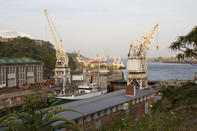River of Buffaloes
East London is known for its river port which is developed at the mouth of the Buffalo River. The port can comfortably accommodate large ocean going ships due to its 12 m depth at low water, six quays on the east bank, and seven wharfs and quays on the west bank.

Nomadic pastoral tribes in the area originally named the river ‘Ingaad! ab’, meaning ‘river of buffaloes’, and the Xhosa called it ‘Bisho’, which also means ‘buffalo’. European settlers in the area noticed the possibilities for a harbour and development began after the Sixth Frontier War. With the area under British control, the river mouth was examined by Colonel Harry Smith (who was chief of staff to the governor at the time) for the possibility of establishing a port where supplies could be landed.
In November 1836 the brig Knysna, owned by George Rex, arrived ready to trade. Mixed cargo was landed and a Union Jack was nailed to a tree on Signal Hill, overlooking the west bank of the river. In addition, due to the success of the landing, the river mouth was named Port Rex.
Over the next 10 years the British Government gave up control of the area and no further developments were made to the harbour. When the Seventh Frontier War broke out the harbour gained considerable significance after the barque, Frederick Huth unloaded military stores there. After that the harbour was used more frequently, and Fort Glamorgan was built to defend it. As time passed, a village developed and was named East London in December 1847. In January 1848 the area was annexed to the Cape Colony.